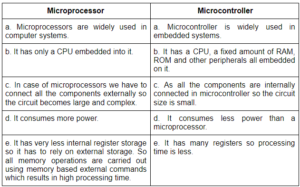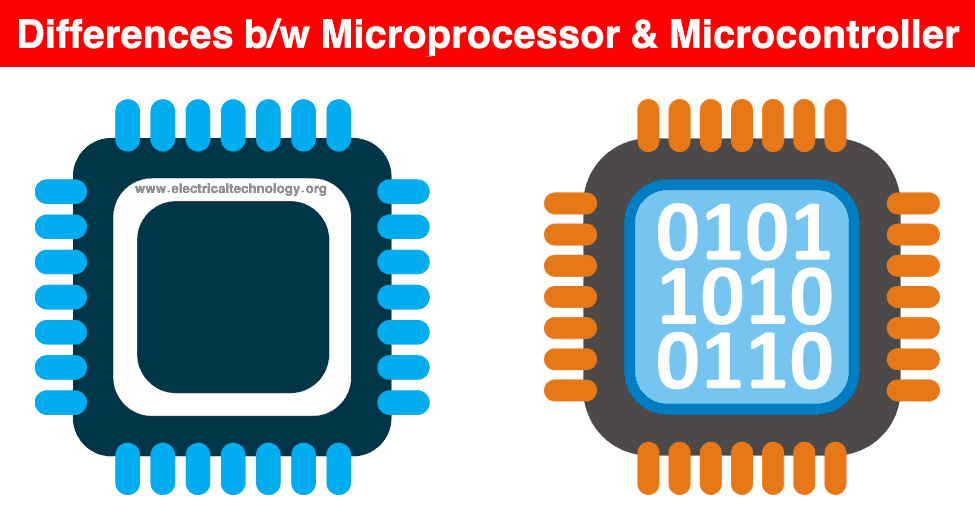Hello friends, in today’s post you have been told about difference between microprocessor and microcontroller, what happens, how it works, so let’s start
Difference between Microprocessor and Microcontroller

A microprocessor is a programmable chip that can perform a variety of operations; executes the program. The block diagram of a microprocessor is shown in the figure. It consists of major parts like ALU, accumulator, registers and timing and ALU control unit.
A microcomputer built on a single chip is called a microcontroller. It has all the properties of a microcomputer but it is built for a specific purpose. The block diagram of a microcontroller is shown in the figure.
The timer/counter, 1/0 port, serial port, microprocessor, RAM and ROM are the main parts of a microcontroller.
Definition of Microprocessor and Microcontroller
Definition of Microprocessor
The microprocessor silicon chip acts as the Central Processing Unit (CPU). It can perform operations including logic and arithmetic according to pre-programmed instructions specified by the manufacturer. A CPU consists of ALU (Arithmetic and Logical Unit), Registers and Control Unit. A microprocessor can be designed in a number of ways, depending on the system architecture.
There are two system architectures available for designing microprocessors – Harvard and Von-Neumann. A Harvard type processor is included with separate buses for program and data memory. In contrast, processors based on von-Neumann architecture share the same bus for program and data memory.
The microprocessor is not an independent unit that depends on other hardware units such as memory, timers, interrupts controllers, and so forth. The first microprocessor was developed by Intel in 1971 and was named the Intel 4004.
Definition of Microcontroller
Microcontroller is the technology which is developed after microprocessor and overcomes the shortcomings of microprocessor. The microcontroller chip is highly integrated with the CPU, memory (RAM and ROM), registers, interrupt control unit, and dedicated I/O ports. It is a superset of microprocessor. Unlike microprocessor, microcontroller is not dependent on other hardware units, it contains all necessary blocks for proper functioning.
Microcontroller is more valuable than microprocessor in the field of embedded systems as it is more cost effective and readily available. The first microcontroller TMS 1000 was developed by Texas Instruments in 1974. The basic design of TI’s microcontroller closely resembles Intel’s 4004/4040 (4-bit) processors with added RAM, ROM, I/O support for developers. Another advantage of microcontrollers is that we can write custom instructions to the CPU.
Following are some differences between microprocessor and microcontroller.
| Sl0 | microprocessor | microcontroller |
| 1. | A microprocessor is a programmable chip, also known as a CPU. | It is a single chip microcomputer designed for a specific task. |
| 2. | Microprocessor has only one memory (registers) for data and program. | Microcontrollers have separate memory for data and program. |
| 3. | There are many instructions for data transfer between memory, input/output and microprocessor. | It contains only one or two instructions for data transfer. |
| 4. | Microprocessor has longer access time | Microcontrollers have relatively short access times. |
| 5. | Very few pins in a microprocessor are multifunction. | While microcontroller has more pin multifunction than this. |
Microprocessor V/S Micro controller
Microprocessor and microcontroller are specialized programmable electronic chips that are used for various purposes.
The key difference between them is that a microprocessor is a programmable computation engine consisting of an ALU, CU and registers, usually used as a processing unit (like the CPU in a computer) that can perform computations and can take decisions.
On the other hand, a microcontroller is a specialized microprocessor that is considered as a “computer on a chip” because it integrates components such as the microprocessor, memory, and parallel digital I/O.
Microcontrollers are primarily designed for managing real-time tasks, unlike microprocessors.
In this post you will know-
Comparison Chart of Microprocessor and Microcontroller
| basis of comparison | microcontroller | |
| basic | Composed of a single silicon chip, containing the ALU, CU and registers. | Microprocessor consists of memory, I/O port, interrupt control unit etc. |
| Speciality | dependent unit | self contained unit |
| i/o port | It does not have a Bill In I/O port | Has built-in I/O ports |
| type of operation | General purpose in design and operation. | Application Oriented or Domain Specific. |
| target | high end market | Embedded market |
| power consumption | Provides low power saving options | Includes more power saving options |
Key Differences Between Microprocessor and Microcontroller
- A microprocessor is made up of a silicon chip that contains an arithmetic logic unit (ALU), a control unit (CU) and registers. In contrast, a microcontroller includes the features of a microprocessor along with RAM, ROM, counters, I/O ports.
- The microprocessor requires other chips such as timers, interrupt controllers, and program and data memory that it depends on. The microcontroller does not require other hardware units as it is already capable of this.
- Micro-controllers are provided with implantable I/O ports whereas microprocessors do not employ built-in I/O ports. Microprocessor performs general purpose operations. In contrast, microcontroller applications perform embedded operations.
- Power utilization in microcontroller is better than microprocessor.
conclusion
The microprocessor can carry out general-purpose operations for many different tasks. In contrast, the microcontroller can perform user-defined functions where it handles a single task for the entire life cycle.
If you liked this article Difference between Microprocessor and Microcontroller, then you must share this post with your friends and the topic () on which you should read or notes If you want, then we must comment () Your comments are of great value to us. Thank you
